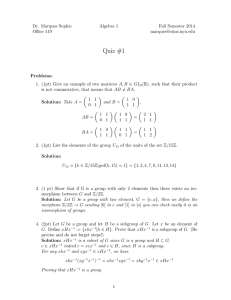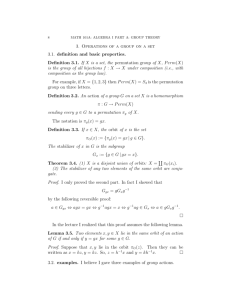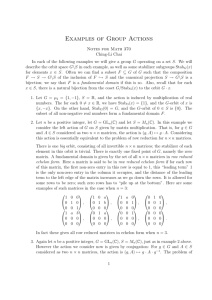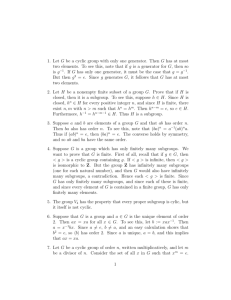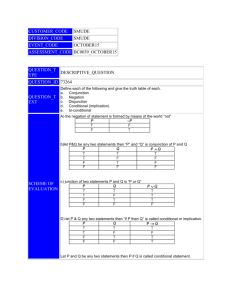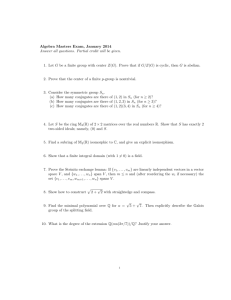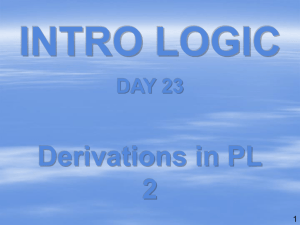SOLUTION SET 1 Problem 1: Let G be the group of rotational
advertisement
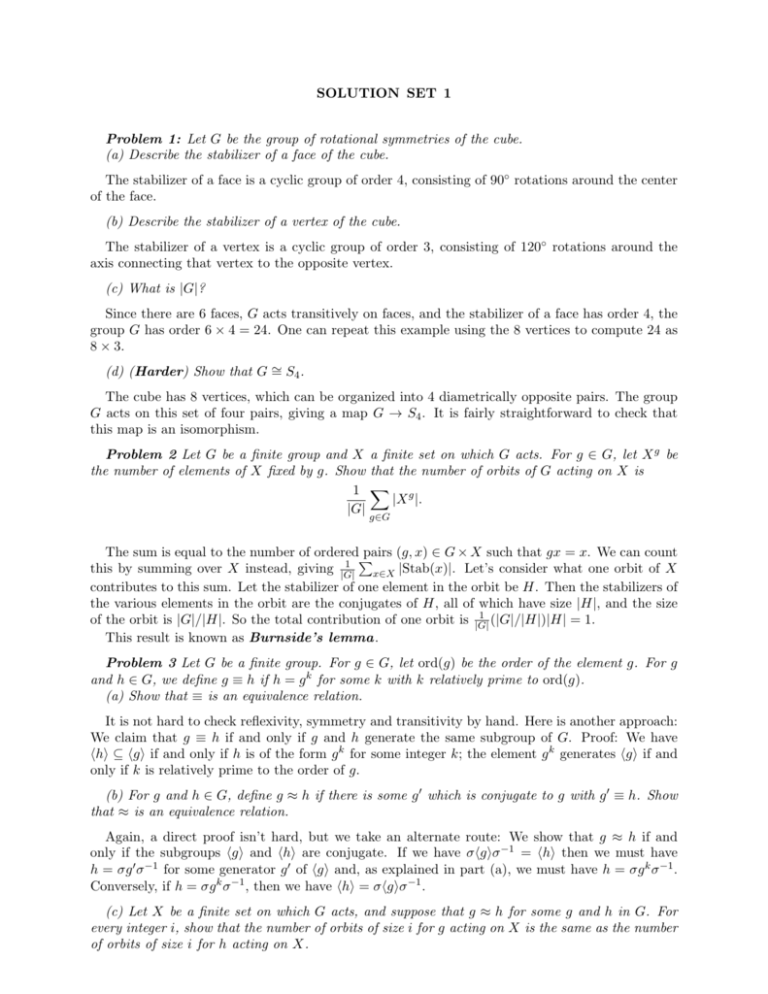
SOLUTION SET 1
Problem 1: Let G be the group of rotational symmetries of the cube.
(a) Describe the stabilizer of a face of the cube.
The stabilizer of a face is a cyclic group of order 4, consisting of 90◦ rotations around the center
of the face.
(b) Describe the stabilizer of a vertex of the cube.
The stabilizer of a vertex is a cyclic group of order 3, consisting of 120◦ rotations around the
axis connecting that vertex to the opposite vertex.
(c) What is |G|?
Since there are 6 faces, G acts transitively on faces, and the stabilizer of a face has order 4, the
group G has order 6 × 4 = 24. One can repeat this example using the 8 vertices to compute 24 as
8 × 3.
(d) (Harder) Show that G ∼
= S4 .
The cube has 8 vertices, which can be organized into 4 diametrically opposite pairs. The group
G acts on this set of four pairs, giving a map G → S4 . It is fairly straightforward to check that
this map is an isomorphism.
Problem 2 Let G be a finite group and X a finite set on which G acts. For g ∈ G, let X g be
the number of elements of X fixed by g. Show that the number of orbits of G acting on X is
1 X g
|X |.
|G|
g∈G
The sum is equal to the number of orderedP
pairs (g, x) ∈ G × X such that gx = x. We can count
1
this by summing over X instead, giving |G| x∈X |Stab(x)|. Let’s consider what one orbit of X
contributes to this sum. Let the stabilizer of one element in the orbit be H. Then the stabilizers of
the various elements in the orbit are the conjugates of H, all of which have size |H|, and the size
1
of the orbit is |G|/|H|. So the total contribution of one orbit is |G|
(|G|/|H|)|H| = 1.
This result is known as Burnside’s lemma.
Problem 3 Let G be a finite group. For g ∈ G, let ord(g) be the order of the element g. For g
and h ∈ G, we define g ≡ h if h = g k for some k with k relatively prime to ord(g).
(a) Show that ≡ is an equivalence relation.
It is not hard to check reflexivity, symmetry and transitivity by hand. Here is another approach:
We claim that g ≡ h if and only if g and h generate the same subgroup of G. Proof: We have
hhi ⊆ hgi if and only if h is of the form g k for some integer k; the element g k generates hgi if and
only if k is relatively prime to the order of g.
(b) For g and h ∈ G, define g ≈ h if there is some g 0 which is conjugate to g with g 0 ≡ h. Show
that ≈ is an equivalence relation.
Again, a direct proof isn’t hard, but we take an alternate route: We show that g ≈ h if and
only if the subgroups hgi and hhi are conjugate. If we have σhgiσ −1 = hhi then we must have
h = σg 0 σ −1 for some generator g 0 of hgi and, as explained in part (a), we must have h = σg k σ −1 .
Conversely, if h = σg k σ −1 , then we have hhi = σhgiσ −1 .
(c) Let X be a finite set on which G acts, and suppose that g ≈ h for some g and h in G. For
every integer i, show that the number of orbits of size i for g acting on X is the same as the number
of orbits of size i for h acting on X.
Let h = σg k σ −1 . Consider the bijection σ from X to X, we claim that this bijection takes
g-orbits to h-orbits. Suppose that the g-orbit of x is x, gx, g 2 x, . . . , g m−1 x for some m dividing
the order of g. Then the h-orbit of σx is σx, hσx = σg k x, h2 σx = σg 2k x, . . . , σg (m−1)k x. Since
k is relatively prime to the order of g, the sequence 0, k, 2k, 3k, . . . , (m − 1)k modulo m is a
permutation of 0, 1, 2, . . . , (m − 1).
(d) (Harder) Let G be a finite group and suppose that g 6≈ h for some g and h in G. Construct
a finite set X on which G acts so that the orbits of g on X have different sizes than the orbits of h.
Let H be the group hhi and let X = G/H. Then h has a one element orbit on G/H. Since hgi
is not conjugate to H, there is no element of G/H that is stabilized by hgi, so hgi does not have
an orbit of size 1 on X.
Problem 4 Let G T
be a finite group. Let H be a subgroup of G with n = [G : H].
(a) Show that [G : x∈G xHx−1 ] divides n!.
Set Z = G/H. So G acts on Z, giving
→ Sn . For x ∈ G, the group xHx−1
T a map G
is the stabilizer of the coset xH in Z, so x∈G xHx−1 is the kernel of the map G → Sn . So
T
[G : x∈G xHx−1 ] is the size of the image of this map. Since this image is a subgroup of Sn , its
size divides n!.
(b) Suppose that n is the smallest prime dividing |G|. Show that H is normal in G.
T
Since [G : x∈G xHx−1 ] is the index of a subgroup of |G|, it divides |G|. We also just showed
T
that it divides n!. So [G : x∈G xHx−1 ] divides GCD(|G|, n!). All the prime factors of |G| other
than n don’t divide n!, since they are larger than n. Also, n only
T divides n! once (using that n is
prime). So GCD(|G|, n!) is the prime n and we see that [G : x∈G xHx−1 ] must be n. But we
T
T
have G ⊇ H ⊇ x∈G xHx−1 and H has index n in G, so we conclude that H = x∈G xHx−1 . The
right hand side is clearly normal in G, so we have shown that H is normal.
This was the problem from an old QR exam.
Problem 5 Let G be a group and let X be a finite set on which G acts transitively and with
trivial stabilizer.
(a) Let H be the group of bijections φ : X → X such that φ(g · x) = g · φ(x) for all g ∈ G. Show
that H ∼
= G.
This was probably the hardest problem. The first thing to do is to reject is the easy guess the
maps in H are of the form x 7→ hx for some h ∈ H. Unless G is abelian, this map does not obey
the required conditions.
Choose x ∈ X. So g 7→ gx is a bijection from G to X. Let φ be a map in H, with φ(x) = hx.
Then we have φ(gx) = ghx. So every map in H is of the form gx 7→ ghx for some h ∈ G; we write
φh for the map gx 7→ ghx. Conversely, for every h ∈ H, it is easy to check that the map gx 7→ ghx
obeys the required condition.
However, this doesn’t give an isomorphism because φh1 h2 (gx) = gh1 h2 x and φh1 φh2 (gx) =
φh1 (gh2 x) = gh2 h1 x. We can fix this by defining the isomorphism G → H by h 7→ φh−1 .
(b) To what extent is your isomorphism in (a) uniquely determined by the data of G and X?
Suppose that we used the element y = σx in place of x. The map φh , defined using x, took gx
to ghx. In terms of y, it took gσ −1 y to ghσ −1 y = (gσ −1 )σhσ −1 y. So the map which was called φh
would now be called φσhσ−1 .
Problem 6 Which of the following short exact sequences are semi-direct:
In each case, we must determine whether or not we can split the right hand map.
(a) 0 → A5 → S5 → Z/2 → 0?
Yes. A splitting is to take the generator of Z/2 to (12).
(b) 0 → Z/2 → Z/6 → Z/3 → 0?
Yes, a splitting is to take 1 + 3Z to 4 + 6Z. In fact, this sequence is direct; we can split the other
map by taking 1 + 6Z to 1 + 2Z.
(c) 0 → Z/3 → Z/9 → Z/3 → 0?
No. None of the preimages of a generator for Z/3 have order 3.
(d) 0 → {1, i, −1, −i} → Q → Z/2 → 0, where Q is the eight element subgroup of the quaternions
consisting of {±1, ±i, ±j, ±k}?
No. None of the preimages of a generator for Z/2 have order 2.
Problem 7 Let G, A, B and C be finite groups. Consider the following three statements:
(1) There are subgroups P ⊂ Q ⊂ G, with P normal in Q and Q normal in G, such that P ∼
= A,
Q/P ∼
= B and G/Q ∼
= C.
(2) There is a normal subgroup Q of G such that we have short exact sequences 0 → Q → G →
C → 0 and 0 → A → Q → B → 0.
(3) There is a quotient group R of G such that we have short exact sequences 0 → A → G →
R → 0 and 0 → B → R → C → 0.
(a) Two of these statements are logically equivalent. Which two?
Statements (1) and (2) are logically equivalent. If (1) holds, then by definition we have a short
exact sequence 0 → Q → G → C → 0 and, since P is normal in Q, we have a short exact sequence
0 → P → Q → Q/P → 0; by hypothesis, Q/P ∼
= B and P ∼
= A.
Conversely, if (2) holds, define Q to be the image of the map Q → G from the first short exact
sequence and define P to be the image of the composition A → Q → G; the claims are easy to
check.
(b) Show that the remaining statement implies the other two.
Suppose we have (3); we will show (2). Write π for the map G → R and let Q = π −1 (B). Then
Q is normal in G, since B is normal in R, and we have G/Q ∼
= R/B ∼
= C. Meanwhile, we have a
surjection π from Q to B (by definition), whose kernel is A. So we have established (2).
(c) (Harder) Give an example of a group G for which the two statements of (a) are true but
the remaining statement is false.
We need to use a group G which has P normal in Q and Q normal in G but P not normal in G.
One is tempted to use the example from class: Z/2 n (Z/p)2 , with the Z/2 switching the two
coordinates. However, by bad luck, the supgroup P of Z/p2 where the two coordinates are equal
is normal in G.
0 1 ;
One fix is to instead use G = Z/3 n (Z/p)2 , where p ≡ 2 mod 3 and Z/3 acts by α = −1
−1
the groups A, B and V are Z/p, Z/p and Z/3. The characteristic polynomial of A is A2 + A + 1,
which has no roots in Z/p for p ≡ 2 mod 3, so there are no α-fixed subspaces of (Z/p)2 and hence
no p-element normal subgroups.
